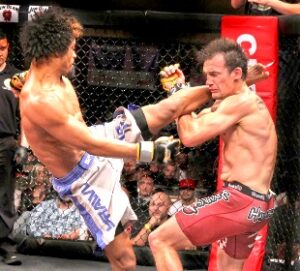
Are you wondering whether there are belts in MMA?
In this article, we’ll answer whether there are belts in MMA and explore some of the MMA belt systems available.
Contents
Are There Belts in MMA? (MMA Belt Ranks)
In 2023, there are no universally adopted ranking belts in MMA like there are in martial arts judo, karate, and Brazilian jiu-jitsu.
Instead of a belt system in MMA, practitioners are split into three categories:
- Amateur MMA fighter: someone who’s had at least one amateur MMA fight
- Professional MMA fighter: someone with a professional MMA license and has received money for an MMA fight
- Hobbyists: practitioners who train in mixed martial arts (MMA) for many reasons outside of competing/fighting
However, the International Mixed Martial Arts Federation (IMMAF) introduced a belt grading system for MMA in 2022, which was used at the 2022 IMMAF Youth MMA World Championships. IMMAF is the global governing body of amateur MMA and serves MMA associations and federations globally.
It’s unclear at this time how widespread the IMMAF MMA belt system is or will become, but any amateur MMA association wanting to compete at the IMMAF Youth MMA World Championships must adopt and adhere to the new MMA belt system.
Any MMA school wanting to adopt the IMMAF MMA belt system simply needs to join the federation/association in their country which is a member of the IMMAF.
Let’s take a closer look at the IMMAF MMA belt system and the reasons it was created.
IMMAF MMA Belt System
The IMMAF MMA belt system was introduced to help keep students at MMA schools in order to grow the sport – it isn’t proof of fighting ability.
IMMAF believes 95% of MMA practitioners are recreational and only 5% competitive, so having an MMA belt system keeps the recreational majority invested as they can track their growth and have the next level to aim and build to.
The IMMAF MMA belt system also prevents technical mismatches as fighters are evaluated on a standardized set of techniques and compete against those of the same belt.
The only things to judge before were a fighter’s record and opponents faced which can make it hard to judge the ability of a fighter. This is especially true when countries are competing and the competency, culture, coaching, and MMA infrastructure differ.
Here are the IMMAF’s MMA belts in order:
- Yellow
- Orange
- Green
- Blue
- Purple
- Brown
- Black
To achieve an MMA black belt, practitioners must be at least 18 years old. To advance an MMA belt rank, practitioners must spend a minimum of 1 year with their current belt and learn and demonstrate the technical progression scheme for each belt color.
There are 230 techniques and ten types of technical competence in the grading scheme, which are as follows.
- Striking attacks
- Striking defenses
- Kicks
- Kicks defense
- Fence control
- Fence escapes
- Takedowns
- Submissions
- Submission defenses
- Groundwork reversals
Here you can see the IMMAF’s yellow belt rank techniques. IMMAF-certified coaches are at least a blue belt and must evaluate a student before they progress to the next belt.
Coaches are evaluating students on the following criteria.
- Understanding of force application
- Correct technique
- Movement literacy
At the higher belts, students have to demonstrate this while sparring with a cooperative partner.
Other MMA Belt Systems
There are some MMA schools using their own developed MMA belt system, but they’re not recognized on a large scale and are mostly seen as a money-making system.
Aside from the IMMAF MMA belt system, one of the best MMA coaches, Greg Jackson, developed his own MMA belt ranking system in 2012 which applied to both fighters and recreational MMA practitioners.
However, much like the lesser-known schools around the world which introduced their own MMA belt ranking system, Jackson’s MMA belt system made no waves, and information about it completely stopped not long after its introduction.
Why Does MMA Have No Belts?
Aside from the new IMMAF MMA belt system, MMA has no belts because it hasn’t been around long enough for this kind of standardization. MMA started in the early 90s and it wasn’t until November 2000 that the Official Unified Rules of MMA were introduced.
Also, by definition, MMA is a mix of many different martial arts, some of which have a belt system and some don’t, and there’s no way to standardize the variety of belts MMA practitioners have from various martial arts.
Also, MMA has no belts because they’re not used when fighting. In Bjj, practitioners can grab their opponent’s belt and they can also use their belt to choke or tie up an opponent as long as it’s still tied around their waist.
Lastly, while MMA is a martial art in its own right, it’s more so a combat sport and has been developed for the purpose of competition, entertainment, and business.
Before MMA was the Gracie Challenge, a no-holds-barred (no rules) competition to see if martial artists of different styles could defeat a Gracie – a family of extremely advanced Brazilian jiu-jitsu practitioners. This business idea was turned into the UFC, which is still the premier MMA promotion today.
Essentially, the only question in MMA is can you beat your opponent? MMA has no belt system because it hasn’t needed one.
The Bottom Line
So, ‘Are there belts in MMA?’
While there isn’t a universally adopted MMA belt system like other traditional martial arts have, in 2021 the IMMAF introduced an MMA belt system that applies to the IMMAF Youth MMA World Championships.
It’s unclear how widespread this will become so soon after it was introduced, but it’s one of the ways IMMAF intends to grow amateur MMA and MMA overall.




